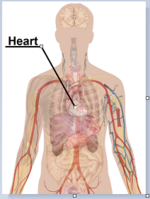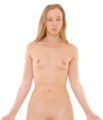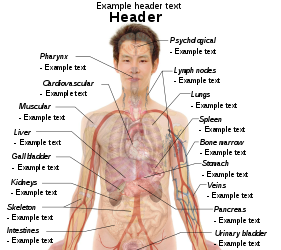فَیِل:Surface projections of the organs of the trunk.png
Appearance

نُمٲشِہ ہُنٛد ناپ: 374 × 598 پِکسَل باقی ریزولوشَن: 150 × 240 پِکسَل | 300 × 480 پِکسَل | 480 × 768 پِکسَل | 640 × 1٬024 پِکسَل | 1٬583 × 2٬533 پِکسَل
اَصلی فَیِل (1٬583 × 2٬533 پِکسَل، فَیِل ناپ: 3٫33 میگا بایِٹ، MIME قسٕم:image/png)
فَیِل تَوٲریٖخ
فَیِل وُچھنہٕ باپتھ کٔریو کلک تأریخ/وقت پؠٹھ تاکہِ یہ گژھِ تمہ وقتہٕ ظٲہر
| تٲریٖخ/وَقت | تھمب نیل | پہلوٗو | صٲرِف | کَتھ | |
|---|---|---|---|---|---|
| موجودٕ | 09:19, 27 دَسَمبَر 2019 |  | 1٬583 × 2٬533 (3٫33 میگا بایِٹ) | Mikael Häggström | +Costal margin |
| 10:38, 11 نَوَمبَر 2010 |  | 1٬050 × 1٬680 (2٫07 میگا بایِٹ) | Mikael Häggström | Adapted to recently added overview images. Distinguished different ways to designate vertebrae levels. | |
| 10:04, 7 نَوَمبَر 2010 |  | 936 × 1٬325 (1٫77 میگا بایِٹ) | Mikael Häggström | update from svg | |
| 09:46, 7 نَوَمبَر 2010 |  | 936 × 1٬325 (1٫77 میگا بایِٹ) | Mikael Häggström | update from svg | |
| 04:51, 24 اَکتوٗبَر 2010 |  | 936 × 1٬325 (1٫61 میگا بایِٹ) | Mikael Häggström | Smoother edges | |
| 05:18, 10 اَکتوٗبَر 2010 |  | 936 × 1٬325 (1٫61 میگا بایِٹ) | Mikael Häggström | Minor kidney adjustment. More realistic hip bone | |
| 04:47, 6 اَکتوٗبَر 2010 |  | 936 × 1٬325 (1٫73 میگا بایِٹ) | Mikael Häggström | Distinguished stomach and spleen. Removed painted arteries out of scope. | |
| 18:40, 4 اَکتوٗبَر 2010 |  | 936 × 1٬325 (1٫74 میگا بایِٹ) | Mikael Häggström | Lowered spleen | |
| 15:21, 3 اَکتوٗبَر 2010 |  | 936 × 1٬325 (1٫74 میگا بایِٹ) | Mikael Häggström | Decreased some opacity. Aligned tail of pancreas with spleen. Adjusted fissure marking width. | |
| 18:20, 2 اَکتوٗبَر 2010 |  | 936 × 1٬325 (1٫72 میگا بایِٹ) | Mikael Häggström | +liver label |
فَیِلٕ ہُند اِستِعمال
یہِ صَفہٕ چھُ اَتھ فَیِلہِ اِستِمال کَران:
فَیِلہٕ ہُنٛد عالمِی اِستِمال
دِنہٕ آمٕتیٚو باقٕی وِکیٖیَن منٛز چھےٚ یہِ بٕہی استعمال سپدان:
- af.wikipedia.org پؠٹھ استعمال
- ar.wikipedia.org پؠٹھ استعمال
- as.wikipedia.org پؠٹھ استعمال
- bcl.wikipedia.org پؠٹھ استعمال
- bn.wikipedia.org پؠٹھ استعمال
- bs.wikipedia.org پؠٹھ استعمال
- ca.wikipedia.org پؠٹھ استعمال
- ckb.wikipedia.org پؠٹھ استعمال
- da.wikipedia.org پؠٹھ استعمال
- de.wikipedia.org پؠٹھ استعمال
- en.wikipedia.org پؠٹھ استعمال
- Kidney
- Rib cage
- Surface anatomy
- Thorax
- McBurney's point
- Torso
- User talk:Arcadian/Archive 4
- Celiac artery
- Transverse plane
- Abdomen
- Situs solitus
- Transpyloric plane
- Wikipedia talk:WikiProject Anatomy/Archive 2
- Wikipedia:Picture peer review/Trunk anatomy
- Wikipedia:Featured picture candidates/Organs of the trunk
- Wikipedia:Picture peer review/Archives/Oct-Dec 2010
- Wikipedia:Featured picture candidates/November-2010
- Vertebral column
- Talk:Human anatomy/Archive 1
- eo.wikipedia.org پؠٹھ استعمال
- eu.wikipedia.org پؠٹھ استعمال
- fa.wikipedia.org پؠٹھ استعمال
- fi.wikipedia.org پؠٹھ استعمال
View more global usage of this file.
































